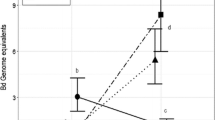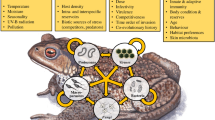Abstract
Chytridiomycosis is an emerging infectious disease of amphibians caused by the fungal pathogen Batrachochytrium dendrobatidis (Bd), which has led to devastating declines in amphibian populations worldwide. Current theory predicts that Bd infections are maintained through both reproduction on the host’s skin and reinfection from sources outside of the host. To investigate the importance of external reinfection on pathogen burden, we infected captive-bred individuals of the highly susceptible Panamanian Golden Frog, Atelopus glyphus, and wild-caught glass frogs, Espadarana prosoblepon, with Bd. We housed the animals in one of three treatments: individually, in heterospecific pairs, and in conspecific pairs. For 8 weeks, we measured the Bd load and shedding rate of all frogs. We found that Atelopus had high rates of increase in both Bd load and shedding rate, but pathogen growth rates did not differ among treatments. The infection intensity of Espadarana co-housed with Atelopus was indistinguishable from those housed singly and those in conspecific pairs, despite being exposed to a large external source of Bd zoospores. Our results indicate that Bd load in both species is driven by pathogen replication within an individual, with reinfection from outside the host contributing little to the amplification of host fungal load.






Similar content being viewed by others
References
Anderson RM, May RM (1978) Regulation and stability of host-parasite population interactions: I. Regulatory processes. Journal of Animal Ecology 47:219-247
Anderson RM, May RM (1981) The population dynamics of microparasites and their invertebrate hosts. Philosophical Transactions of the Royal Society London Series B 291:451–52
Angeli NF, DiRenzo GV, Cunha A, and Lips KR (2015) Effects of density on spatial aggregation and habitat associations of the glass frog Espadarana (Centrolene) prosoblepon. Journal of Herpetolology 49:388–394
Bates D, Maechler M, Ben Bolker B, Walker S (2015) Fitting Linear Mixed-Effects Models Using lme4. Journal of Statistical Software 67:1-48. https://doi.org/10.18637/jss.v067.i01.
Berger L, Marantelli G, Skerratt LL, and Speare R (2005) Virulence of the amphibian chytrid fungus Batrachochytrium dendrobatidis varies with the strain. Diseases of Aquatic Organisms 68:47–50
Berger L, Speare R, Daszak P, Green DE, Cunningham AA, Goggin CL, Slocombe R, Ragan MA, Hyatt AD, McDonald KR, Hines HB, Lips KR, Marantelli G, and Parkes H (1998) Chytridiomycosis causes amphibian mortality associated with population declines in the rain forests of Australia and central America. Proceedings of the National Academy of Sciences 95:9031–9036
Boyle DG, Boyle DB, Olsen V, Morgan, JAT, and Hyatt, AD (2004) Rapid quantitative detection of chytridiomycosis. Diseases of Aquatic Organisms 60:141–148.
Briggs CJ, Knapp RA, and Vredenburg VT (2010) Enzootic and epizootic dynamics of the chytrid fungal pathogen of amphibians. Proceedings of the National Academy of Sciences 107:9695–9700
Briggs CJ, Vredenburg VT, Knapp RA, and Rachowicz LJ (2005) Investigating the population-level effects of chytridiomycosis: An emerging infectious disease of amphibians. Ecology 86:3149–3159
Cheng TL, Rovito SM, Wake DB, and Vredenburg VT (2011) Coincident mass extirpation of neotropical amphibians with the emergence of the infectious fungal pathogen Batrachochytrium dendrobatidis. Proceedings of the National Academy of Sciences 108:9502–9507. https://doi.org/10.1073/pnas.1105538108
Crawford AJ, Lips KR, and Bermingham E (2010) Epidemic disease decimates amphibian abundance, species diversity, and evolutionary history in the highlands of central Panama. Proceedings of the National Academy of Sciences 107:13777–13782
Daszak P, Cunningham AA, and Hyatt AD (2000) Emerging infectious diseases of wildlife–threats to biodiversity and human health. Science 287:443–449
DiRenzo GV, Langhammer PF, Zamudio KR, and Lips KR (2014) Fungal infection intensity and zoospore output of Atelopus zeteki, a potential acute chytrid supershedder. PLoS ONE 9:e93356.
DiRenzo GV, Campbell Grant, EH, Longo AV, Che-Castaldo C, Zamudio KR., and Lips KR. (2018) Imperfect pathogen detection from non-invasive skin swabs biases disease inference. Methods Ecol. Evol. 9:380–389.
Ellison AR, Tunstall T, DiRenzo GV, Hughey MC, Rebollar EA, Belden LK, Harris RN, Ibáñez R, Lips KR, and Zamudio KR (2015) More than skin deep: functional genomic basis for resistance to amphibian chytridiomycosis. Genome Biology and Evolution 7:286–298
Gagliardo R, Crump P, Griffith E, Mendelson J, Ross H, and Zippel K (2008) The principles of rapid response for amphibian conservation, using the programmes in Panama as an example. International Zoo Yearbook 42:125–135
Hyatt, AD, Boyle DG, Olsen V, Boyle DB, Berger L, Obendorf D, et al. (2007) Diagnostic assays and sampling protocols for the detection of Batrachochytrium dendrobatidis. Diseases of Aquatic Organisms 73:175–92.
Kriger KM, and Hero J-M (2006) Survivorship in wild frogs infected with chytridiomycosis. EcoHealth 3:171–177
Langhammer, PF, Lips KR, Burrowes, PA, Tunstall TS, Palmer CM, and Collins JP (2013) A fungal pathogen of amphibians, Batrachochytrium dendrobatidis, attenuates in pathogenicity with in vitro passages. PLoS ONE 8;1–9.
Lenth RV (2016) Least-Squares Means: The R Package lsmeans. Journal of Statistical Software, 69, 1-33. https://doi.org/10.18637/jss.v069.i01
Lips KR, Brem F, Brenes R, Reeve JD, Alford RA, Voyles J, Carey C, Livo L, Pessier AP, and Collins JP (2006) Emerging infectious disease and the loss of biodiversity in a neotropical amphibian community. Proceedings of the National Academy of Sciences 103:3165–3170
Lips KR, Reeve JD, and Witters LR (2003) Ecological traits predicting amphibian population declines in Central America. Conservation Biology 17:1078–1088.
Lips KR, Diffendorfer J, Mendelson JR, Sears MW (2008) Riding the wave: reconciling the roles of disease and climate change in amphibian declines. PLoS Biol 6:e72
Longcore JE, Pessier AP, Nichols DK (1999) Batrachochytrium Dendrobatidis gen. et sp. nov., a chytrid pathogenic to amphibians. Mycologia 91: 219–227.
Louca S, Lampo M, and Doebeli M (2014) Assessing host extinction risk following exposure to Batrachochytrium dendrobatidis. Proceedings of the Royal Society B 281:20132783. https://doi.org/10.1098/rspb.2013.2783
Maguire C, DiRenzo GV, Tunstall TS, Muletz CR, Zamudio KR, and Lips KR. (2016) Dead or alive? Viability of chytrid zoospores shed from live amphibian hosts. Dis. Aquat. Organ. 119: 179–187.
McCaffery R, and Lips K (2013) Survival and abundance in males of the glass frog Espadarana (Centrolene) prosoblepon in Central Panama. J. Herpetol. 47:162–168
Miller DAW, Talley BL, Lips, KR, and Campbell Grant EH. (2012) Estimating patterns and drivers of infection prevalence and intensity when detection is imperfect and sampling error occurs. Methods Ecol. Evol. 3:850–859.
Poole V (2008) Project golden frog. Endangered Species Bulletin 33:7–10
Rachowicz LJ & Briggs, CJ (2007) Quantifying the disease transmission function: effects of density on Batrachochytrium dendrobatidis transmission in the mountain yellow-legged frog Rana muscosa. Journal of Animal Ecology 76:711–72
Rachowicz LJ & Vredenburg VT (2004) Transmission of Batrachochytrium dendrobatidis within and between amphibian life stages. Diseases of Aquatic Organisms 61:75–83
R Development Core Team (2014) R: A Language and Environment for Statistical Computing. R Foundation for Statistical Computing, Vienna, Austria.
Schloegel LM, Ferreira CM, James TY, Hipolito M, Longcore JE, Hyatt AD, Yabsley M, Martins AMCRPF, Mazzoni R, Davies AJ, and Daszak P (2010) The North American bullfrog as a reservoir for the spread of Batrachochytrium dendrobatidis in Brazil. Animal Conservation 13:53–61. https://doi.org/10.1111/j.1469-1795.2009.00307.x
Skerratt L, Berger L, Speare R, Cashins S, McDonald K, Phillott A, Hines H, and Kenyon N (2007) Spread of chytridiomycosis has caused the rapid global decline and extinction of frogs. EcoHealth 4:125–134. M3: https://doi.org/10.1007/s10393-007-0093-5
Smith KG, Lips KR, Chase JM (2009) Selecting for extinction: nonrandom disease-associated extinction homogenizes amphibian biotas. Ecol Lett 12:1069–1078
Therneau T (2015). A Package for Survival Analysis in S. version 2.38, http://CRAN.R-project.org/package=survival.
Voyles J, Woodhams DC, Saenz V, Byrne AQ, Perez R, Rios-sotelo G, Ryan MJ, Bletz MC, Sobell FA, Mcletchie S, Reinert L, Rosenblum EB, Rollins-smith LA, Ibáñez R, Ray JM, Griffith EJ, Ross H, Richards-zawacki CL (2018) Shifts in disease dynamics in a tropical amphibian assemblage are not due to pathogen attenuation. Science 359:1517–1519
Vredenburg VT, Knapp RA, Tunstall TS, and Briggs CJ (2010) Dynamics of an emerging disease drive large-scale amphibian population extinctions. Proceedings of the National Academy of Sciences 107:9689–9694
Wake DB and Vredenburg VT (2008) Are we in the midst of the sixth mass extinction? A view from the world of amphibians. Proceedings of the National Academy of Sciences 105:11466–11473. https://doi.org/10.1073/pnas.0801921105
Weldon C, du Preez LH, Hyatt AD, Muller R, and Speare R (2004) Origin of the amphibian chytrid fungus. Emerging Infectious Diseases 10:2100–2105
Woodhams DC, Voyles J, Lips KR, Carey C, and Rollins-Smith LA (2006) Predicted disease susceptibility in a Panamanian amphibian assemblage based on skin peptide defenses. Journal of Wildlife Diseases 42:207–218
Acknowledgements
Daniel Medina, Edward Kabay and Molly Bletz helped with sample collection. Jorge Guerrel provided assistance and advice for animal care. Roberto Ibáñez was supported by the Panama Amphibian Rescue and Conservation project, and the Sistema Nacional de Investigación. Graziella V. DiRenzo was supported by a National Science Foundation Graduate Research Fellowship. This research was funded under NSF DEB 1120161 (PIs: KRL and KRZ) with ANAM permit #SE/AH-5-12.
Author information
Authors and Affiliations
Contributions
GVD, KRL, TST conceived of and designed the study. TST and MSdV conducted the experiment. GVD executed data analysis, modeling, and co-wrote the first draft of the manuscript. TST conducted the experiments in RI’s laboratory, executed data analysis, modeling, and co-wrote the first draft of the manuscript. KRL was involved with experimental design, manuscript preparation and collected the original dataset. AVL performed the laboratory work in the KRZ laboratory. All authors edited the manuscript. The work was funded by KRL and KRZ.
Corresponding author
Ethics declarations
Conflict of interest
The authors declare that they have no conflict of interest.
Data Availability
The datasets and R code used in the current study are available through GitHub: https://github.com/tatet2/AtelopusBdTranmission.
Statement of Animal Ethics
All applicable institutional and/or national guidelines for the care and use of animals were followed.
Electronic supplementary material
Below is the link to the electronic supplementary material.
Rights and permissions
About this article
Cite this article
DiRenzo, G.V., Tunstall, T.S., Ibáñez, R. et al. External Reinfection of a Fungal Pathogen Does not Contribute to Pathogen Growth. EcoHealth 15, 815–826 (2018). https://doi.org/10.1007/s10393-018-1358-x
Received:
Revised:
Accepted:
Published:
Issue Date:
DOI: https://doi.org/10.1007/s10393-018-1358-x




